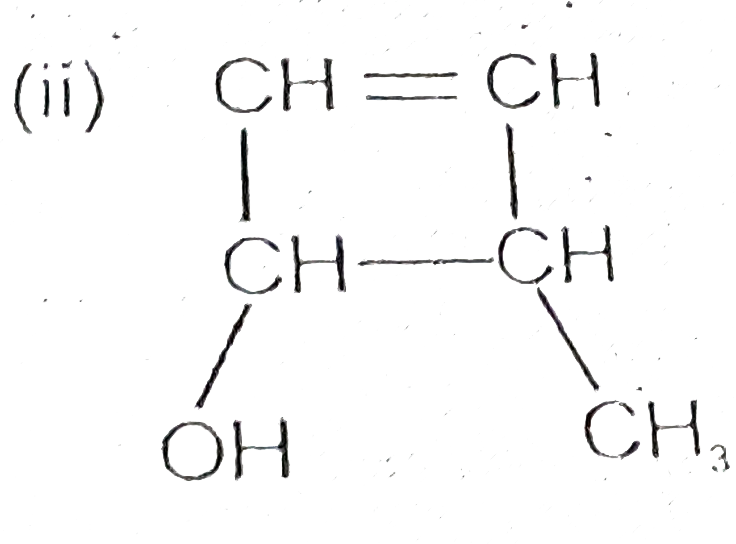Complete Solutions to TRY YOURSELF of chapter ORGANIC CHEMISTRY: SOME BASIC PRINCIPLE AND TECHNIQUES of Class 12 book with complete answers and questions
| Class 12 | CHEMISTRY |
| Chapter | ORGANIC CHEMISTRY: SOME BASIC PRINCIPLE AND TECHNIQUES |
| AAKASH INSTITUTE | TRY YOURSELF |
| Number Of Questions | 28 |
| Academic Year | 2023-24 |
Indicate the `sigma & pi` bonds in
(i) `CH_(2)Cl_(2)`
(ii) `CH_(3)-C-=C-CH_(3)`
View SolutionOn the basis of hydribidsation predict the shape of the following molecules
(i) `CH_(3)F`
(ii) `CH_(2)=O`
View SolutionWrite its bond line formula
(i) `CH_(3)CH(OH)CH_(2)CH_(2)OH`
View SolutionExpand each of the structure

View SolutionDraw the bond line structure for

View SolutionWrite three-dimensional representation for `CH_(3)CH_(2)OH` compound.
View SolutionGive the IUPAC name

View SolutionGive its IUPAC name.
View SolutionWrite the IUPAC names of the following compounds
(i) `CH_(3)-CH_(2)-overset(O)overset(||)(C)-CH_(2)-overset(O)overset(||)(C)-CH_(3)`
(ii) `CH_(3)-overset(O)overset(||)(C)-CH_(2)-CH_(2)-CH_(2)-CH_(2)-COOH`
(iii) `CH_(3)-underset(C_(2)H_(5))underset(|)(CH)-underset(C_(2)H_(5))underset(|)(CH)-CH_(3)`
View SolutionDerive the structure of (i) 2-Chlorohexane, (ii) Pent-4-en-2-ol, (iii) 3- Nitrocyclohexene, (iv) Cyclohex-2-en-1-ol, (v) 6-Hydroxy- heptanal.
View SolutionDraw all the possible isomers of `C_(4)H_(8)O` (containing carbonyl group)
View SolutionWhat is the relation between 2-methyl propanaol-1 and 2-methoxy propane?
View SolutionUsing curved-arrow notation, show the formation of reactive intermediates when the following covalent bonds undergo heterolytic cleavage.
(a) `CH_(3)–SCH_(3)`, (b) `CH_(3)–CN`, (c) `CH_(3)–Cu`
View SolutionClassify the following molecules/ions as nucleophiles or electrophiles
`HS^(-),BF_(3),CH_(3)CH_(2)O^(-),NO_(2)^(+),NH_(3),NH_(2)^(-),Cl^(+)`
View SolutionDraw the resonating strcuture for `C_(6)H_(5)CHO` compound.
View SolutionArrange the following carbocations in increasing order of stability and mention basis of the order suggested
(i) `overset(o+)(C)H_(3)" "`(ii) `CH_(3)overset(o+)(C)H_(2)" "`(iii) `CH_(3)overset(o+)(C)HCH_(3)" "`(iv) `CH_(3)-underset(CH_(3))underset(|)overset(o+)(C)-CH_(3)`
View SolutionOn complete combustion, 0.246 g of an organic compound gave 0.198g of carbon dioxide and 0.1014g of water. Determine the percentage composition of carbon and hydrogen in the compound
View Solution0.2613g of an organic compound on combustion in oxygen gave 0.8844 g of carbon dioxide and 0.1809 of water Find the % of carbon and hydrogen in the substance.
View Solution0.2313 g of an organic substance gave 40 ml of moist nitrogen measured at `15^(@)C` and 745 mm pressure. Calcualte the % of nitrogen (Aq tension at `15^(@)C` is 12.7mm)
View Solution0.27g of an organic compound gave on combustion 0.396 of `CO_(2)` 0.216g of `H_(2)O` 0.36g of the same substance gave 48.88 ml of `N_(2)` at 290K and 740mm pressure Calculate the percentage composition of the compound.
View Solution0.2g of an organic compound of kjedahl's analysis gave enough ammonia to just neutralise 20ml of 0.1N `H_(2)SO_(4)` Calculate the % of nitrogen in the compound.
View SolutionA sample of 0.50 g of an organic compound was treated according to Kjeldahl's method. The ammonia evolved was absorbed in 50 mL of 0.5 M `H_(2)SO_(4)`. The residual acid required 60 mL of 0.5 M solution of NaOH for neutralisation. What would be the percentage composition of nitrogen in the compound?
View SolutionIn Carius method of estimation of halogen, 0.15 g of an organic compound gave 0.12 g of AgBr. Find out the percentage of bromine in the compound.
View Solution0.525g of an organic compound gave 0.356g of silver chloride by a halogen estimation method. Find the % of Cl in the compound.
View Solution0.2595 g of an organic substance, when treated by carius method gave 0.25g of `BaSO_(4)` calculates the % of S in the compound.
View SolutionIn sulphur estimation, 0.157 g of an organic compound gave 0.4813 g of barium sulphate. What is the percentage of sulphur in the compound?
View Solution0.092 g of an organic compound containing phosphorus gave 0.111 g `Mg_(2)P_(2)O_(7)` by usual analysis. Calculate the % of phosphorus in the organic compound.
View Solution0.12 gm of an organic compound containing phosphorus gave 0.22 gm of `Mg_2P_2O_7` by the usual analysis. Calculate the percentage of phosphorus in the compound.
View Solution
TRY YOURSELF questions and complete solutions for chapter ORGANIC CHEMISTRY: SOME BASIC PRINCIPLE AND TECHNIQUES of AAKASH INSTITUTE ENGLISH of Class 12
All Exercises from AAKASH INSTITUTE Class 12 CHEMISTRY ORGANIC CHEMISTRY: SOME BASIC PRINCIPLE AND TECHNIQUES
- ASSIGNMENT SECTION-A COMPETITION LEVEL QUESTIONS
- EXAMPLE
- ILLUSTRATION
- SECTION-B OBJECTIVE TYPE QUESTION (ONE OPTION IS CORRECT)
- SECTION-C OBJECTIVE TYPE QUESTION (MORE THAN ONE OPTIONS ARE CORRECT)
- SECTION-D LINKED COMPREHENSION TYPE QUESTIONS
- SECTION-E ASSERTION-REASON TYPE QUESTIONS
- SECTION-F MATRIX-MATCH TYPE QUESTIONS
- SECTION-G INTEGER ANSWER TYPE QUESTIONS
- SECTION-H MULTIPLE TRUE-FALSE TYPE QUESTION
- SECTION-I SUBJECTIVE TYPE QUESTIONS
- SECTION-J AAKASH CHALLENGERS QUESTIONS
- TRY YOURSELF